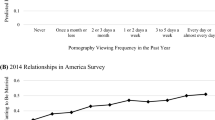Abstract
The determination of paternity is important due to the possibility of cuckoldry and the subsequent squandering of male reproductive effort. Men may be attuned to prevalence rates of cuckoldry in the local environment to assess risk. However, women may have an enhanced ability to assess paternity and may have superior insight into women’s sexual infidelity. Accordingly, this study examined subjective estimates of human non-paternity (HNP), the discrepancy between social/legal versus genetic paternity. The hypothesis was that women would provide higher estimates of HNP than men. A sex difference in the hypothesized direction was observed across four community samples of Austrian adults (totalling 763 men and 795 women), with women overall providing higher HNP estimates than men (14.5% vs. 9.1%). Furthermore, key demographic variables impacted HNP estimates for both sexes: individuals who were unmarried, childless, currently unpartnered, or currently in a romantic relationship of a shorter duration provided higher HNP estimates than their counterparts, thus suggesting that such estimates might be attuned to mating effort and strategies, as well as relationship quality and investment.
Similar content being viewed by others
References
Ashton, G. C. (1980). Mismatches in genetic markers in a large family study. American Journal of Human Genetics, 32, 601–613.
Ayton, P., & Wright, G. (1994). Subjective probability: What should we believe? In G. Wright & P. Ayton (Eds.), Subjective probability (pp. 163–184). New York: Wiley.
Baker, R. R., & Bellis, M. A. (1995). Human sperm competition: Copulation masturbation, and infidelity. London: Chapman and Hall.
Bauer, A. (1996). Volkszählung 1991: Lebensgemeinschaften [Austrian census 1991: Cohabitations]. Statistische Nachrichten, 51, 585–590.
Bellis, M. A., & Baker, R. R. (1990). Do females promote sperm competition? Data for humans. Animal Behavior, 40, 997–999.
Bredart, S., & French, R. M. (1999). Do babies resemble their fathers more than their mothers? A failure to replicate Christenfeld & Hill. Evolution and Human Behavior, 20, 129–135.
Brock, D. J. H., & Shrimpton, A. E. (1991). Nonpaternity and prenatal genetic screening. Lancet, 338, 1151.
Buss, D. M. (1994). The evolution of desire: Strategies of human mating. New York: Basic Books.
Buss, D. M. (2000). The dangerous passion: Why jealousy is as necessary as love and sex. New York: Free Press.
Cerda-Flores, R., Barton, S. A., Marty-Gonzalez, L. F., Rivas, F., & Chakraborty, R. (1999). Estimation of nonpaternity in the Mexican population of Nuevo Leon: A validation study with blood group markers. American Journal of Physical Anthropology, 109, 281–293.
Christenfeld, N. J. S., & Hill, E. A. (1995). Whose baby are you? Nature, 378, 669.
Cosmides, L., & Tooby, J. (1996). Are humans good intuitive statisticians after all? Rethinking some conclusions of the literature on judgment under uncertainty. Cognition, 58, 1–73.
Daly, M., & Wilson, M. (1982). Whom are newborns said to resemble? Ethology and Sociobiology, 3, 69–78.
Diamond, J. A. (1991). The rise and fall of the third chimpanzee. London: Vintage Books.
Diamond, J. A. (2003). Dr. Louis Klein Diamond: Faculty of Medicine Memorial Minute. Retrieved December 16, 2008, from www.news.harvard.edu/gazette/2002/05.30/18-mmdiamond.html, 2002.
Gaulin, S. J. C., McBurney, D. H., & Brakeman-Wartell, S. L. (1997). Matrilateral biases in the investment of aunts and uncles: A consequence and measure of paternity uncertainty. Human Nature, 8, 139–151.
MacIntyre, S., & Sooman, A. (1991). Non-paternity and prenatal genetic screening. Lancet, 338, 869–871.
McLain, D. K., Setters, D., Moulton, M. P., & Pratt, A. E. (2000). Ascription of resemblance of newborns by parents and nonrelatives. Evolution and Human Behavior, 21, 11–23.
Neel, J. V., & Weiss, K. M. (1975). The genetic structure of a tribal population, the Yanomama Indians. XIII. Biodemographic Studies. American Journal of Physical Anthropology, 42, 25–51.
Regalski, J. M., & Gaulin, S. J. C. (1993). Whom are Mexican infants said to resemble? Monitoring and fostering paternal confidence in the Yucatan. Ethology and Sociobiology, 14, 97–113.
Russell, R. J. H., & Wells, P. A. (1987). Estimating paternity confidence. Ethology and Sociobiology, 8, 215–220.
Sasse, G., Müller, J., Chakraborty, R., & Ott, J. (1994). Estimating the frequency of nonpaternity in Switzerland. Human Heredity, 44, 337–343.
Sykes, B., & Irven, C. (2000). Surnames and the Y chromosome. American Journal of Human Genetics, 66, 1417–1419.
Symons, D. (1979). The evolution of human sexuality. New York: Oxford University Press.
Voracek, M. (2001). Marital status as a candidate moderator variable of male-female differences in sexual jealousy: The need for representative population samples. Psychological Reports, 88, 553–566.
Wellings, K., Fields, J., Johnson, A., & Wadsworth, J. (1994). Sexual behaviour in Britain: National survey of sexual attitudes and lifestyles. London: Penguin.
Acknowledgment
The contributions of Angelika Hofhansl, Bettina Manfrini, Helga Preston-Leikauf, and Cornelia Stadlhuber to data collection for this research are gratefully acknowledged.
Author information
Authors and Affiliations
Corresponding author
Rights and permissions
About this article
Cite this article
Voracek, M., Fisher, M. & Shackelford, T.K. Sex Differences in Subjective Estimates of Non-Paternity Rates in Austria. Arch Sex Behav 38, 652–656 (2009). https://doi.org/10.1007/s10508-009-9525-3
Received:
Revised:
Accepted:
Published:
Issue Date:
DOI: https://doi.org/10.1007/s10508-009-9525-3




